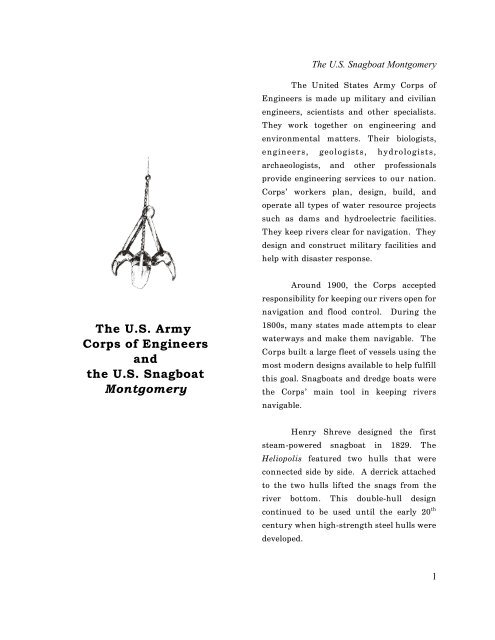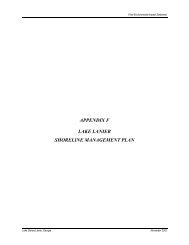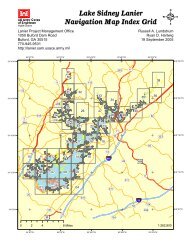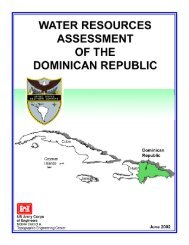The U.S. Army Corps of Engineers and the U.S. Snagboat Montgomery
The U.S. Army Corps of Engineers and the U.S. Snagboat Montgomery
The U.S. Army Corps of Engineers and the U.S. Snagboat Montgomery
Create successful ePaper yourself
Turn your PDF publications into a flip-book with our unique Google optimized e-Paper software.
<strong>The</strong> U.S. <strong>Snagboat</strong> <strong>Montgomery</strong><br />
<strong>The</strong> United States <strong>Army</strong> <strong>Corps</strong> <strong>of</strong><br />
<strong>Engineers</strong> is made up military <strong>and</strong> civilian<br />
engineers, scientists <strong>and</strong> o<strong>the</strong>r specialists.<br />
<strong>The</strong>y work toge<strong>the</strong>r on engineering <strong>and</strong><br />
environmental matters. <strong>The</strong>ir biologists,<br />
engineers, geologists, hydrologists,<br />
archaeologists, <strong>and</strong> o<strong>the</strong>r pr<strong>of</strong>essionals<br />
provide engineering services to our nation.<br />
<strong>Corps</strong>’ workers plan, design, build, <strong>and</strong><br />
operate all types <strong>of</strong> water resource projects<br />
such as dams <strong>and</strong> hydroelectric facilities.<br />
<strong>The</strong>y keep rivers clear for navigation. <strong>The</strong>y<br />
design <strong>and</strong> construct military facilities <strong>and</strong><br />
help with disaster response.<br />
<strong>The</strong> U.S. <strong>Army</strong><br />
<strong>Corps</strong> <strong>of</strong> <strong>Engineers</strong><br />
<strong>and</strong><br />
<strong>the</strong> U.S. <strong>Snagboat</strong><br />
<strong>Montgomery</strong><br />
Around 1900, <strong>the</strong> <strong>Corps</strong> accepted<br />
responsibility for keeping our rivers open for<br />
navigation <strong>and</strong> flood control. During <strong>the</strong><br />
1800s, many states made attempts to clear<br />
waterways <strong>and</strong> make <strong>the</strong>m navigable. <strong>The</strong><br />
<strong>Corps</strong> built a large fleet <strong>of</strong> vessels using <strong>the</strong><br />
most modern designs available to help fulfill<br />
this goal. <strong>Snagboat</strong>s <strong>and</strong> dredge boats were<br />
<strong>the</strong> <strong>Corps</strong>’ main tool in keeping rivers<br />
navigable.<br />
Henry Shreve designed <strong>the</strong> first<br />
steam-powered snagboat in 1829. <strong>The</strong><br />
Heliopolis featured two hulls that were<br />
connected side by side. A derrick attached<br />
to <strong>the</strong> two hulls lifted <strong>the</strong> snags from <strong>the</strong><br />
river bottom. This double-hull design<br />
continued to be used until <strong>the</strong> early 20 th<br />
century when high-strength steel hulls were<br />
developed.<br />
1
<strong>The</strong> U.S. <strong>Snagboat</strong> <strong>Montgomery</strong><br />
generally operated in t<strong>and</strong>em with barges<br />
<strong>and</strong> tug (or tow) boats. A barge would be<br />
tied to <strong>the</strong> snagboat. As <strong>the</strong> snags were<br />
lifted, <strong>the</strong> snagboat would drop <strong>the</strong>m onto<br />
<strong>the</strong> barge. Once <strong>the</strong> barge was full, a tug<br />
boat would take <strong>the</strong> barge away <strong>and</strong> leave<br />
an empty barge in its place. From January<br />
through May <strong>of</strong> each year, <strong>the</strong> snagboat<br />
would go back to dry dock for repairs.<br />
Shreve’s Heliopolis<br />
Snagging operations usually began in<br />
May <strong>of</strong> each year. <strong>The</strong> crews continued<br />
through <strong>the</strong> end <strong>of</strong> <strong>the</strong> year. This was <strong>the</strong><br />
peak time for river traffic. <strong>Snagboat</strong>s<br />
<strong>The</strong> U.S. <strong>Snagboat</strong><br />
<strong>Montgomery</strong><br />
One <strong>of</strong> <strong>the</strong> hardest working<br />
snagboats in <strong>the</strong> Sou<strong>the</strong>ast was <strong>the</strong> U.S.<br />
<strong>Snagboat</strong> <strong>Montgomery</strong>. <strong>The</strong> <strong>Montgomery</strong><br />
was built for <strong>and</strong> commissioned by <strong>the</strong><br />
<strong>Corps</strong> <strong>of</strong> <strong>Engineers</strong>. She was built in 1926<br />
by <strong>the</strong> Charleston Dry Dock <strong>and</strong> Machine<br />
U.S. <strong>Snagboat</strong> <strong>Montgomery</strong> in 1929<br />
2
<strong>The</strong> U.S. <strong>Snagboat</strong> <strong>Montgomery</strong><br />
Company <strong>of</strong> Charleston, South Carolina.<br />
From 1926 until 1933, she worked on <strong>the</strong><br />
Alabama <strong>and</strong> Coosa rivers. In 1933, <strong>the</strong><br />
Black Warrior <strong>and</strong> Tombigbee rivers were<br />
added to her responsibilities. She continued<br />
pulling snags from <strong>the</strong>se river systems until<br />
1959, when she was transferred to Panama<br />
City, Florida. She worked on <strong>the</strong><br />
Apalachicola, Chattahoochee, <strong>and</strong> Flint<br />
rivers from 1959 to <strong>the</strong> end <strong>of</strong> her career.<br />
hoisting. One winch turns <strong>the</strong> boom in front<br />
<strong>of</strong> <strong>the</strong> boat while <strong>the</strong> o<strong>the</strong>r lifts <strong>the</strong> snag.<br />
<strong>The</strong> <strong>Montgomery</strong> still has its original scotch<br />
boiler. This boiler created steam to power<br />
<strong>the</strong> boat. Water was heated inside a cylinder<br />
within <strong>the</strong> boiler. <strong>The</strong> steam made in <strong>the</strong><br />
boiler rises to <strong>the</strong> top <strong>and</strong> passes through<br />
steam lines to <strong>the</strong> engine room. <strong>The</strong> engine<br />
room is located in <strong>the</strong> stern or back <strong>of</strong> <strong>the</strong><br />
boat<br />
<strong>The</strong> <strong>Snagboat</strong> <strong>Montgomery</strong> has a<br />
riveted steel hull <strong>and</strong> wood superstructure.<br />
Her overall length, including <strong>the</strong><br />
paddlewheel is approximately 54 meters<br />
(177 feet). She is approximately 10 meters<br />
wide (about 33 feet). <strong>The</strong> <strong>Montgomery</strong> has<br />
three decks. <strong>The</strong> steam engine <strong>and</strong> snagging<br />
machinery, crew quarters, <strong>and</strong> <strong>the</strong> engine<br />
room are located on <strong>the</strong> main deck. This<br />
deck is also called <strong>the</strong> hurricane deck. <strong>The</strong><br />
second deck contains <strong>the</strong> galley or kitchen,<br />
<strong>of</strong>ficers’ quarters, <strong>and</strong> an <strong>of</strong>fice. <strong>The</strong><br />
pilothouse at <strong>the</strong> top <strong>of</strong> <strong>the</strong> boat contains<br />
controls for <strong>the</strong> snagging boom <strong>and</strong> engine<br />
room. <strong>The</strong> boom is operated by two large<br />
steam winches. A winch is a large drum for<br />
winding a rope or chain used for hauling or<br />
When it was first built, <strong>the</strong> boiler<br />
burned coal. After World War II, it is was<br />
converted to burn fuel. <strong>The</strong> paddlewheel is<br />
made <strong>of</strong> steel <strong>and</strong> wood <strong>and</strong> is 5.5 meters in<br />
diameter (18 feet) <strong>and</strong> 6 meters wide<br />
(almost 20 feet). <strong>The</strong> <strong>Montgomery</strong> has a<br />
telegraph machine located in <strong>the</strong> engine<br />
room. <strong>The</strong> machine has a dial with a h<strong>and</strong><br />
that points to different possible engine room<br />
actions <strong>and</strong> is <strong>the</strong> way <strong>the</strong> pilot originally<br />
communicated with <strong>the</strong> engineers. A<br />
similar telegraph is located in <strong>the</strong> pilot<br />
house.<br />
<strong>The</strong> Mongomery’s crew consisted <strong>of</strong><br />
<strong>of</strong>ficers <strong>and</strong> deck h<strong>and</strong>s. Each <strong>of</strong> <strong>the</strong> <strong>of</strong>ficers<br />
had an important job. Each usually trained<br />
Original pr<strong>of</strong>ile drawing <strong>of</strong> <strong>the</strong> <strong>Montgomery</strong><br />
3
<strong>The</strong> U.S. <strong>Snagboat</strong> <strong>Montgomery</strong><br />
<strong>The</strong> <strong>Corps</strong> <strong>of</strong> <strong>Engineers</strong> retired <strong>the</strong><br />
<strong>Montgomery</strong> on 8 November 1982. She was<br />
one <strong>of</strong> only two snagboats remaining in <strong>the</strong><br />
United States. On her final day <strong>of</strong> service,<br />
<strong>the</strong> master wrote <strong>of</strong> <strong>the</strong> <strong>Montgomery</strong> in his<br />
log: “Men are very sad this day!! This boat<br />
has been a Work Horse <strong>of</strong> <strong>the</strong> tri-rivers.”<br />
Telegraph in <strong>the</strong> engine room<br />
for many years to learn to do his job safely<br />
<strong>and</strong> correctly. <strong>The</strong> captain <strong>of</strong> a snagboat<br />
was known as <strong>the</strong> master. He was<br />
responsible for making sure everyone did<br />
<strong>the</strong>ir job. He also took care <strong>of</strong> <strong>the</strong> crew. <strong>The</strong><br />
pilot steered <strong>the</strong> boat. He had to be very<br />
familiar with each river <strong>the</strong> snagboat<br />
worked. <strong>The</strong> operator ran <strong>the</strong> snagging<br />
equipment. <strong>The</strong> chief engineer <strong>and</strong> his<br />
assistant operated <strong>the</strong> steam engines. <strong>The</strong>ir<br />
skill kept <strong>the</strong> boat moving <strong>and</strong> working.<br />
<strong>The</strong> final <strong>of</strong>ficer was <strong>the</strong> oiler. His only job<br />
was keeping all <strong>of</strong> <strong>the</strong> machinery oiled<br />
properly. This was a very important job.<br />
Deck h<strong>and</strong>s did all sorts <strong>of</strong> jobs.<br />
<strong>The</strong>y cleaned, helped run <strong>and</strong> repair<br />
equipment, <strong>and</strong> helped with snagging<br />
operations. <strong>The</strong> cook <strong>and</strong> his helper made<br />
three meals a day for <strong>the</strong> crew. <strong>The</strong>y were<br />
two <strong>of</strong> <strong>the</strong> busiest people on board.<br />
Master’s log book entry<br />
from 8 November 1982<br />
4
















